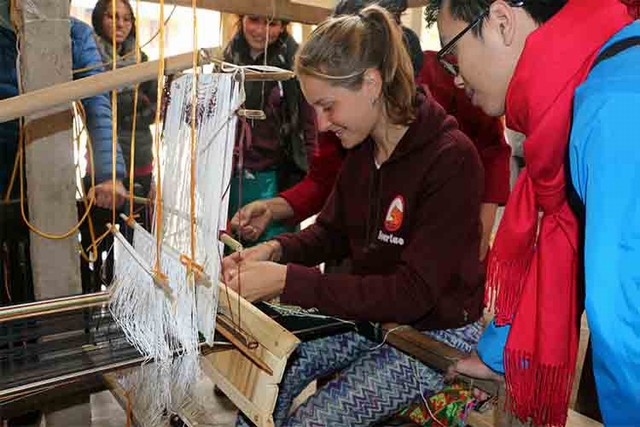Tailor Made Holidays with our travel experts
We'll do our best to call you within 48h

The Thai usually live in bamboo houses built on stilts, and roofs are traditionally thatch. Many Thai households contain stacks of colorful painted chests, mattresses, hand-woven blankets and pillows. They also contain rattan tables, bamboo stools, and numerous baskets.
Traditional dress for many Thai women is a close-fitting skirt like a sarong and a blouse with silver clasps. The Black Thai make a traditional headscarf called a pieu. The pieu is a length of hand-woven black cloth, which is decorated with bright embroidery on either end. The black color is produced naturally from cham, or indigo. Another popular natural dye color is canh kien, which is a deep red color commonly used to make a cloth with supplementary weft called khuyt.
Traditionally, every young Thai girl would learn how to raise silk worms and to make natural dyes, but these skills are not as common as they once were. Still, from the age of 12 or 13 every Thai girl has to learn how to weave and embroider. For her marriage she must make blankets, mattresses and pillow to bring to her new household. She may make blankets from a repertoire of black and white weaving design, or she may make blankets and mattresses out of khuyt or hand-woven cotton.
The shop represents several groups of Thai women assisted by NGO projects. Before these projects were initiated, women had no income other than what they earned by working in the rice paddies. The projects have helped the women with accounting, quality control, natural dyeing, marketing and management. The new products all incorporate the designs and skills, which have been passed down through generations.
Luc Da village, Con Cuong, Nghe An
At first, few women in Luc Da village remembered how to raise silkworms, make natural dyes and weave silk. The project gave them training in both dyeing and silk weaving. Then the women were asked to copy the designs of old pieces of cloth found in the village. Now they make naturally dyed silk scarves and shawls with traditional Thai images. The groups have also been encouraged to grow their own mulberry trees.
Pu Mat Natural Park, Nghe An
This stunning park is located in the middle of the Annamite Range. Pu Mat National Park is located in Anh Son, Con Cuong and Tuong Duong districts, Nghe An Province, about 130km from Vinh City. The park, formerly known as Pu Mat National Reserve, covers an area of over 91,000ha and has 896 flora species, 241 mammal species, 137 bird species, 25 reptiles and 15 amphibians. Many scientists also see Pu Mat as Viet Nam’s great museum of animal gene pool.
Significantly, Pu Mat is one of Viet Nam’s rare forests such as Quang Nam, Danang, Ha Tinh and Thua Thien-Hue where sao la (long-horned bovid or scientific name Pseudoryx nghetinhensis) can be found. Sao la is one of the animals facing extinction, according to the World Conservation Union’s Red List of Endangered Species.
Together with many unique animals, the primitive forest also has many beautiful landscapes. Among the favourite destinations are the 150m Kem Waterfall, Giang River and ethnic minority villages in the forest such as Thai, Tho, Dan Lai and H’Mong.
The trekking tours, where travellers have an opportunity to explore the jungle and unique villages, are among the top choices for visitors of Pu Mat. These tours also allow visitors to speak to ethnic minorities and learn about their arts and culture, visit villages making brocades or tho cam and enjoy special food such as com lam (rice in bamboo cylinders).